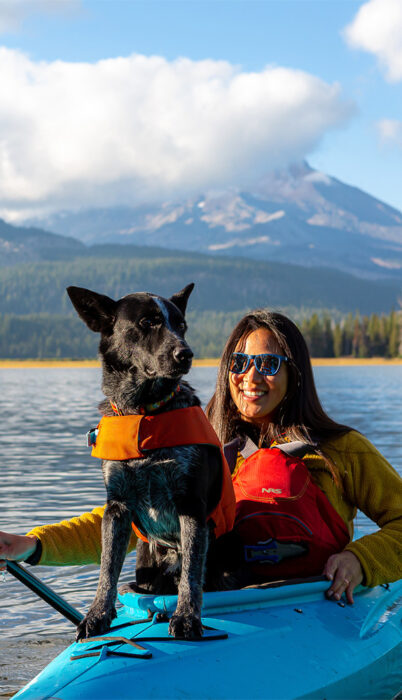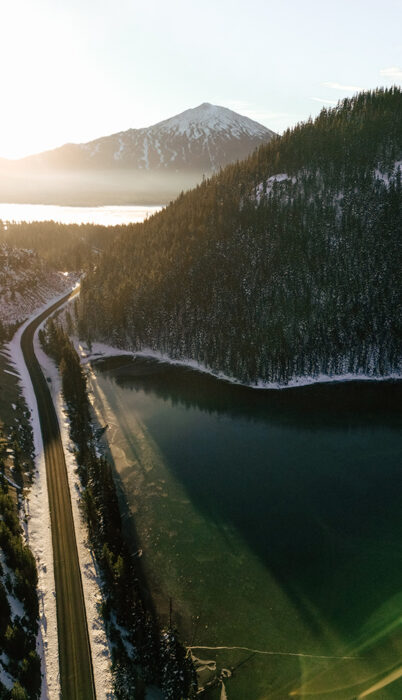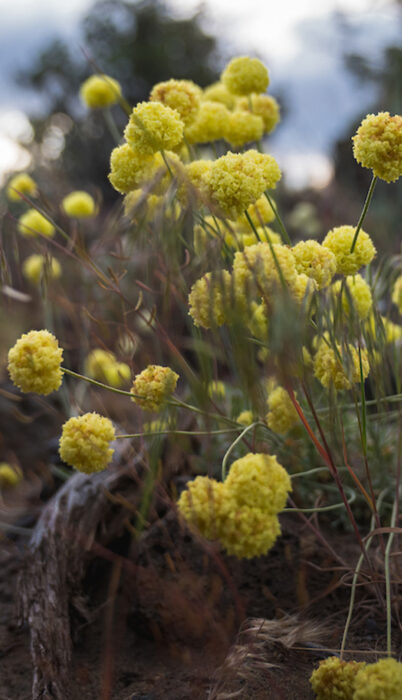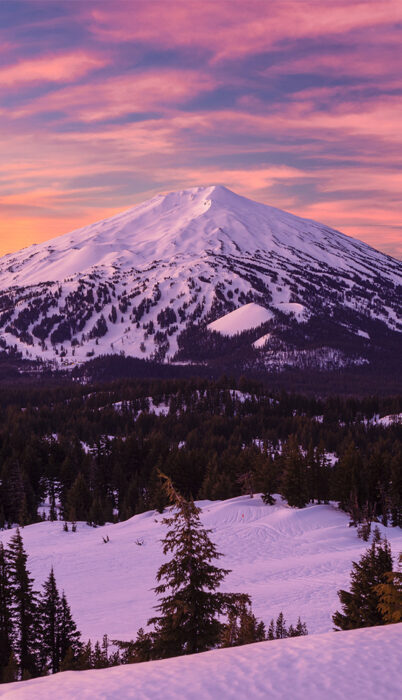
Where to find family-friendly fun in Bend, Oregon
April 17, 2024
6 minute readDon’t let the cold keep you inside! In Bend, hiking in the winter is not only possible, it’s one of the best times of year to take a hike. Imagine uncrowded trails, ample parking, and peaceful landscapes. And once all of the leaves fall, the forest opens up to present expansive and interesting views you can only experience in the wintertime.
Get ready for snow-covered scenery, frozen waterfalls, and the stillness of the high desert. As with any winter outdoor adventure, being well-prepared is crucial to a safe and enjoyable trek. Ensure you’re equipped for the changing conditions and the unique challenges that come with winter hiking in Bend. Properly prepared and ready for winter adventure—you’ll enjoy all the solitude, beauty, and magic of a winter hike in Central Oregon.
Layering is the key to happiness on the trail—or at least comfort! Winter recreation is all about flexibility, especially when it comes to your clothing. You’ll warm up while hiking uphill and you’ll need extra protection from the elements while taking in the views. The goal is to stay warm and dry while being able to adjust to fluctuating temperatures and activity levels. Here’s our essential winter hiking clothing to pack:
Base layer: Start with a moisture-wicking, temperature-regulating base layer. Choose base layers made with Merino wool that pull sweat away from your skin to keep you fresh and dry while fighting odors.
Insulating layer: An insulating layer, like a fleece pullover or puffy jacket, will provide the bulk of your warmth. Make sure this midlayer is breathable, quick-drying, and can be easily packed into a backpack if you need to shed a layer hiking uphill.
Outer layer: Winter days in Bend typically feature two conditions: snow or sun. If you venture out when the snowflakes are falling, you’ll want a shell to zip up over your puffy. Look for a high-quality, waterproof winter jacket and pants that will keep you dry in the snow. Materials like Gore-Tex offer top-of-the-line protection worth the extra dough. And look for features like ventilation zippers, which can help regulate your body temperature during strenuous climbs.
Headwear: Our heads are filled with oxygen-carrying capillaries which fuel our brains and consume a third of the body’s energy. During colder months, it’s important to keep your head covered to maintain function and not lose that precious body heat. Use your noggin and wear a warm hat! Opt for a breathable winter hat that covers your ears. Bring a neck gaiter or scarf to protect your neck and face from wind and cold. In the winter, sunglasses are essential to protect your eyes from snow glare and harmful UV rays even when it’s overcast.
Hands: Because they’re large surface areas with lots of blood vessels, we can lose a lot of heat from our hands. Insulated, waterproof gloves or mittens keep your fingers warm and dry. We like to include some hand warmers, too. A wonder of a scientific invention, hand warmers are a mix of iron, water, activated carbon, vermiculite, cellulose, and salt. Once the warmers are exposed to air, the iron oxidizes and releases heat in the process, keeping your hands nice and toasty. Grab a pack of hand warmers to place in your gloves. Hand warmers typically last 5-8 hours, so one pair is great for a day of outdoor winter adventure.
Footwear: Don’t forget your feet! Most major outdoor footwear brands offer waterproof shoes with good traction tailored for hiking. Many offer insulated shoes for winter hiking, as well. Waterproof hiking shoes provide stellar protection when you’re trekking through mud, puddles, shallow streams, and snow. In the winter, we like to go with taller, over-the-ankle boots for extra defense and added support. And your socks matter just as much as your shoes. It’s best to avoid cotton socks. Cotton is one of the most water-absorbent fabrics with the capacity to absorb up to ten times its weight in moisture. Ditch cotton and opt for less absorbent, quick-drying fabrics like Merino wool.
Additional accessories can significantly enhance your comfort and safety while winter hiking in Bend. Depending on the conditions and terrain where you plan to explore, packing these items may be what turns a good hike into a great hike.
Microspikes or crampons: Microspikes or crampons can provide additional traction on icy or slippery terrain—one of the many reasons why it’s so important to research the terrain where you’re going. If there’s been a recent freeze/thaw cycle, it’s likely you’ll encounter some ice on the trail.
Snowshoes: If you plan to venture into deep snow, snowshoes will be your best friend. Many snow-covered trails are inaccessible without snowshoes, particularly anything that starts at one of Central Oregon’s many sno-parks. Snowshoes help you stay on top of the snow, making hiking less strenuous and more enjoyable.
Gaiters: Grab a pair of gaiters to prevent moisture, dirt, pebbles, and other debris from entering your shoes. Gaiters are also great for keeping snow out of your boots and pants. You’ll definitely want them when hiking through deep snow.
Trekking or ski poles: If you’ve never hiked with trekking poles, once you start, you’ll quickly become a believer. Hiking poles provide stability on slippery or uneven terrain and help you conserve energy for a more enjoyable hike. Many styles fold up, making them super packable and easy to transport.
Daypack and winter accessories: Your daypack serves as your lifeline, carrying the essentials you need for your winter hike. Make sure your pack is comfortable, well-organized, and has adjustable straps to accommodate your winter gear.
Charge up: Make sure you have a fully charged cell phone before you hit the trail. Cold temps will zap your battery fast. Store your phone in interior pockets so your body heat can help keep it warm. This is crucial if you use electronic devices as your primary form of navigation. We recommend always carrying a paper map for this reason. And if you want greater peace of mind, bring a small, portable charger for powering up again when your battery gets low.
Emergency Shelter: A lightweight emergency shelter, such as a space blanket or a bivy sack, can be a lifesaver in case of an unexpected emergency or if you need to stop and rest. Space blankets and bivy sacks are lightweight and packable so you can throw one of them in your daypack with no fuss.
First aid kit: Your first aid kit should include the basics for treating common hiking injuries, along with any personal medications you may need. Include strike-anywhere matches in your kit to enjoy a fire in one of Central Oregon’s winter shelters equipped with wood-burning stoves and stocked with firewood.
Headlamp: Even if you don’t expect to be out after sunset, it’s always a good idea to toss a headlamp in your pack. Ensure it’s in good working condition before your hike and carry extra batteries.
Multi-tool: A multi-tool can be handy for a variety of tasks, from gear repair to food preparation. They make multi-tools that are loaded with features yet impressively small.
Food: Your body burns more calories to stay warm in cold weather. Pack high-energy snacks like trail mix, energy bars, and chocolate. Food that has a higher water content will freeze more quickly so dried fruit and nuts are great options.
Hydration: It’s easy to forget to hydrate in the cold, but drinking enough water in the winter is just as important as any other time of year. Carry an insulated water bottle to prevent it from freezing or use an insulated hydration reservoir. Sip frequently to stay hydrated. A thermos of tea or hot chocolate is a lovely treat to enjoy on the trail and it’ll help keep you nice and toasty.
Need to pick up something you missed? Stop by Mountain Supply, or one of the many outdoor shops scattered throughout Bend, with friendly staff well-versed in winter outdoor recreation to help get you outfitted for a winter day outside.
Know before you go! Research your chosen trail in advance, check the weather forecast, and understand the trail conditions before you venture outside.
Winter Permits: If you’re planning to park at any of the sno-parks in Central Oregon (and we’ve got lots of them), you’ll need a Sno-Park Pass. Pick yours up at the Bend Visitor Center or at most of the ski shops in town.
Communicate where you’re going: Tell someone where you’re hiking and when you expect to be back. Better yet, invite a friend to join you, especially if it’s a friend who is hesitant to hit the trail in the winter. You can be the one to show them that with proper planning and packing, winter hiking can be just as enjoyable as summer hiking.
Chains and snow tires: Your #1 winter hiking priority—make sure your hike is accessible in the winter. Check for winter road closures and whether chains are required to get there. There’s no faster way to sour a winter hiking adventure than getting your car stuck in the snow on the way to the trailhead.
Leave No Trace: Every wild thing you see contributes to a healthy, natural ecosystem. Winter landscapes are particularly delicate as they face the harshest conditions of the year to survive. Please don’t collect rocks, branches, or anything else you find along the trail (unless it’s trash!). Mama nature needs them. Make sure you stay on designated trails, avoid trampling on fragile vegetation, and pack out all trash.
Be considerate: You may have seen some of those “Be nice, you’re in Bend” stickers around town. While it should go without saying, it does seem like we need a reminder from time to time to treat each other with respect. That same kindness should apply on the trail. Remember, public lands are for everyone. You’re always sharing the trail. Please don’t hike on groomed Nordic track. Use only the right trails for your adventure of choice. If a trail requires dogs to be leashed or is off-limits to dogs (like Riley Ranch Nature Preserve, which offers great winter hiking) please mind these rules. If hiking with your four-legged friend is a non-negotiable, plan ahead and find a place for you and your dog to spend the day hiking in the woods.
Keeping your elevation low is key. You’ll have to wait until summer to access those high-alpine trails and Cascade summits. But fear not! There are many great winter hikes in Central Oregon. Favorite options include the Oregon Badlands Wilderness, Smith Rock State Park, and the Deschutes River Trail. Check out this round-up of winter hikes here.

April 17, 2024
6 minute read
March 28, 2024
7 minute read
March 26, 2024
9 minute read
March 1, 2024
8 minute read
February 9, 2024
7 minute read
January 25, 2024
7 minute read